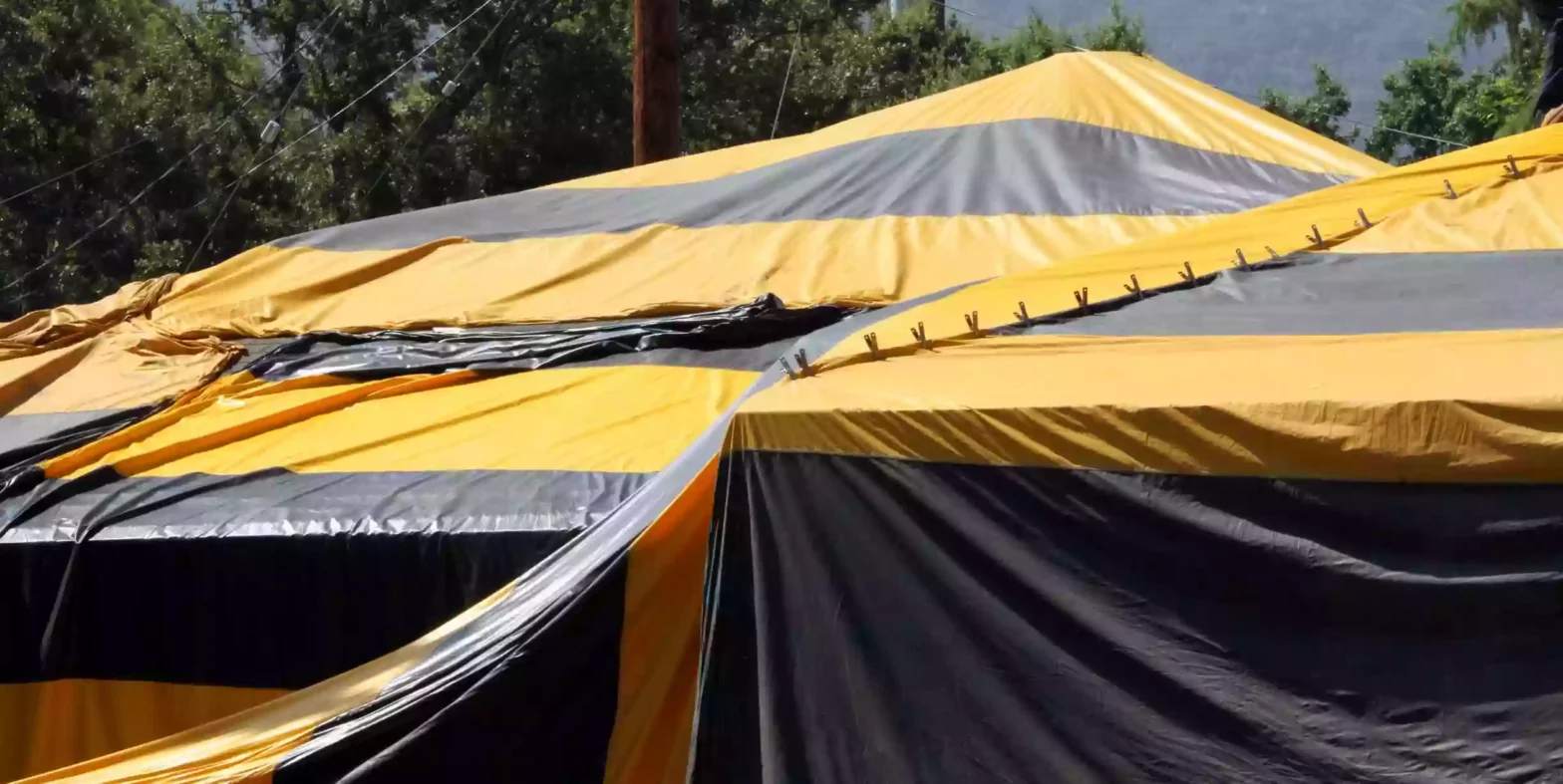
Understanding Tenting for Termites
Termites are a constant problem in South Florida, and managing drywood termite infestations effectively often requires a thorough inspection from a pest control expert to learn about the recommended treatments. Most home and business owners have the same question when finding out they have drywood termites infesting their structure, which is, “Do I need to tent?” In this post, we will explain the “No-Tent” treatment that is preferred among many homeowners, and also when fumigation is recommended.
No-Tent Termite Treatment: A Preferred Option for Early Infestations
No-tent termite treatments are increasingly preferred by homeowners due to their convenience and effectiveness. This method involves the localized application of termite control products, allowing homeowners to remain in their homes without extensive preparations. No-tent treatments are ideal for early, localized infestations where the termite activity is limited to specific areas, or where homeowners want to avoid the hassle and expense of evacuating their homes. The benefits of no-tent treatments include the fact that there is no need to vacate your home or undertake extensive preparations, the cost is often lower compared to tent fumigation, and there is minimal disruption to your daily life.
Determining When Tent Fumigation is Necessary
Tent fumigation is a comprehensive method for dealing with severe or widespread termite infestations. During this process, a tent is placed over the entire structure, and a fumigant gas is used to penetrate all areas of the home, eradicating termites. This method is recommended when the infestation is extensive and has spread throughout the house, multiple areas of the home show signs of termite activity, or there is limited access to the infested areas. For these reasons, it is best to depend on the professionals for a thorough inspection and their recommendation.
How Often Should You Tent for Termites in Florida?
It is a common expression in South Florida for pest control professionals to say that “there are two types of homes in Florida, ones that have termites, and ones that will.” The frequency of tent fumigation is challenging to estimate because it depends on various factors, such as the termite population in your area and the ease of access of swarming termites into your home. However, termite treatments are warrantied. So, if the termites return, so will Hulett.
How to Prepare for Termite Tenting
Preparing for termite tenting involves several steps. First, all residents, including pets, must evacuate the home during the fumigation process. Second, it is crucial to properly seal or remove all food items, medications, and any consumables to prevent contamination. Additionally, any indoor and outdoor plants should be removed or protected to avoid exposure to fumigants. Finally, it is necessary to plan to stay elsewhere for a few days while the fumigation and airing out process is completed. Here at Hulett, we understand this is a lot of information. That is why our trained inspectors will walk you through the process, step by step, and give you a comprehensive checklist to help.
The Importance of Routine Termite Inspections
Regular termite inspections are crucial for early detection and prevention. By identifying termite activity early, you may be able to get control of the infestation before it becomes severe. Routine inspections can help detect early signs of termite activity, allow for timely intervention with No-Tent treatments, and prevent the need for more extensive tent fumigation.
Post-Termite Treatment Home Care by Hulett
Although not mandatory, there are steps you may wish to take following termite tenting that can provide you with additional peace of mind and assurance.
Many homeowners find that thoroughly vacuuming all carpets, floors, furniture, bedding, and curtains helps remove any leftover dead pests, larvae, wings, and eggs.
You do not need to wash clothing, bedding, or any other items. After you re-enter the home you can remove any bagged items from their fumigation containers, return items such as pet food and medication to their proper place, re-attach screened-in porches, relocate shrubbery and landscaping to its original position, and more.
Here at Hulett, we understand this is a lot of information and can feel overwhelming, but don’t worry! In addition to this general overview, our licensed inspectors will provide to you a checklist and discuss with you in detail all of the steps to prepare for fumigation and what to expect during and after treatment.
Can Termites Be Eliminated Without Tenting?
Yes, drywood termites can be eliminated without tenting. Tenting is sometimes needed with severe infestations of drywood termites throughout a home or when accessibility is an issue. However, if accessibility is good, and the infestation is smaller and more localized, then “no tent” options are available for drywood termites. Non-tenting treatments for drywood termites are less-invasive, eliminating the need to relocate your family, pack up your home, move furniture, cut back landscape plants and generally disrupt your life for the better part of a week.
Some professional pest control companies, such as Hulett Environmental Services, offer a no-tent termite treatment for drywood termites. This alternative to tenting involves a non-repellent liquid, foam, or dust that:
- Trained technicians inject advanced products directly into termite galleries
- Worker termites come into contact with the treated surfaces
- Worker termites distribute the product throughout the colony
- Products help eliminate the queen and eradicates the colony
- Technicians also treat common entry points and the attic to help prevent future infestations
Tenting is ineffective against subterranean termites because the colony is also underground in the soil, where they are protected from the fumigant. Subterranean termites can be treated using a non-repellent liquid treatment to the soil, that’s fast-acting and creates a termite barrier around your home. Another solution for eliminating subterranean termites from your property involves pest control professionals installing environmentally-conscious termite bait stations on the perimeter of your property to create a termite boundary around your property. As termites are more attracted to the material in the bait stations, termites find the bait and then distribute it to their colonies, eliminating the subterranean termite colony.
Maintain a Termite-Free Home with Hulett
Preventing termite infestations and maintaining a termite-free home requires ongoing vigilance and professional assistance. Hulett Environmental Services offers comprehensive termite tenting near you, including both tent and no-tent treatments. Our expert technicians, trained by a Board-Certified Entomologist, will inspect your home and recommend the best approach for your specific situation.
Contact Hulett today for a free inspection and let us help you keep your largest asset, your home, protected from termites. Whether you have drywood or subterranean termites, Hulett has the expertise and solutions you need. By understanding the different termite treatment options and staying proactive with routine inspections, you can effectively protect your home from these destructive pests.



